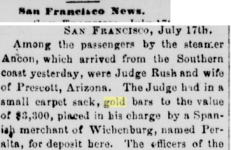Crow
Silver Member
- Jan 28, 2005
- 3,756
- 10,432
- Detector(s) used
- ONES THAT GO BEEP! :-)
- Primary Interest:
- Other
Greetings all. Not quite sure where this all fits. The followings news article.

Why would a judge from Prescott Arizona be carrying a merchants gold for especially one by the name Peralta? That would in 1876 price equate to 379,842 in today's prices.
Crow
Why would a judge from Prescott Arizona be carrying a merchants gold for especially one by the name Peralta? That would in 1876 price equate to 379,842 in today's prices.
Crow







